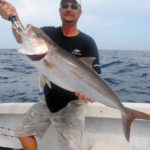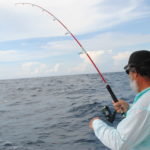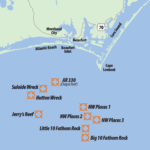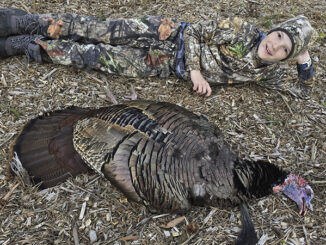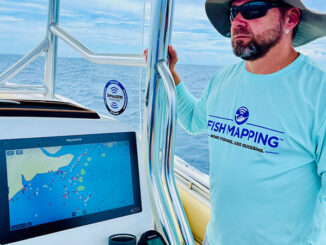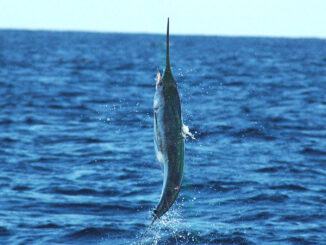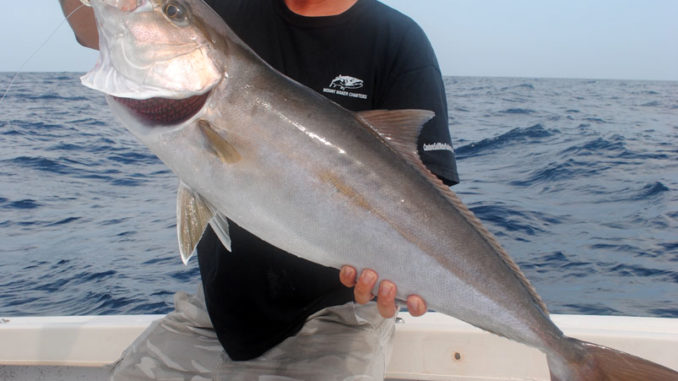
Schools of AJs can be coaxed to back of boat, where they’ll bash your live baits
Amberjacks are the puppy dogs of the sea. Show up around any wreck, rock or reef where they’re keeping company and they’ll come trotting out to investigate, tongues wagging, waiting for you throw them some kind of doggie treat.
Then, they turn into full-grown attack dogs.
How else would you describe a fish that swims up to the back of your boat, almost asking for a handout, and then tries to smash your fishing tackle to bits and leave your muscles quivering masses of jelly?
Welcome to the world of the amberjack, which, surprisingly, contains an awful lot of fishermen.
“You can’t believe how many people actually want to target amberjacks,” said Capt. Joe Shute of Atlantic Beach’s Cape Lookout Fly Shop, who takes plenty of parties on trips to wrecks, rocks and reefs off the Crystal Coast specifically to play tug-of-war with fish that are often referred to as “reef donkeys” because they’re strong, stubborn and dumb as door knobs.
If nothing else is really biting about 10 miles off the beach in July — which happens more often than lots of people like to admit — there’s always the amberjack, which will send any fishermen who thinks he (or she) has strong back and sinewy arms back to the weight room at the local YMCA for some barbell and dumbbell work.
But they’ll come back, because, well, it’s so easy — and it’s so much fun.
The key for Shute, who operates Fish Finder Charters, and his fishing buddy, Capt. Chris Kimrey of Mount Maker Charters in Beaufort, is that the waters off Cape Lookout and the Crystal Coast are full of places where amberjack like to hang out.
“Pretty much any artificial reef, wreck or rock out past 60 feet of water is subject to have amberjack on it,” Kimrey said.
Shute can head out of Beaufort Inlet and take one of two different tacks to fish. He can head off to the southwest about 12 miles to two wrecks — the Suloide and the W.E. Hutton — and AR 330 (the Chapin Reef), which make up an amberjack triangle if there ever was one.
Or he can head roughly south of the inlet for about 10 miles and hit the Big 10, Little 10 and Northwest Places.
“Amberjack will stay in about 55 to 60 feet of water,” said Shute. “That’s about as shallow as they’ll get. They used to show up at the artificial reef right off the beach out of Beaufort Inlet, and they caught them when I was a kid off the Bogue Inlet pier, but not any more. I don’t know why not, but they’ll get on wrecks and live bottom out there in 60 feet of water.
“They’ll move around some — I think they move with the bait — so I like to have about three different pieces of structure in a six- to seven-mile area to check out.”
The brawny jacks, which often reach 50 pounds, show up from offshore when the water temperature reaches the mid-60s in the spring, which usually happens in mid-May. They congregate around pieces of unusual structure on the bottom, rarely venturing in shallower than 60 feet, and they’ll blast most any live bait that’s drifted in front of their noses.
In fact, they’re so aggressive that a savvy captain can offer enough oily, menhaden snacks to pull a school of AJs away from the reef, out in open water where they can be more easily fought after being hooked on rod-and-reel. They’ll almost act like cobia, appearing curious and coming to check out a boat that sets up shop over their living room. They’ll almost act like dolphin, fighting over baits and following a drifting boat even if one of their kind is struggling in the water below and behind the transom, trying to dislodge a big circle hook from its jaws.
“What happens mostly is you pull up on the wreck, stop your boat, and they come up under you,” Shute said. “They’re very curious, and if you have live menhaden to feed them with, they’ll come to you. We’ve kept 20 or 30 behind the boat at a time, pitching menhaden back to them. They really like them better alive than dead, so we don’t do anything to them except pitch them out.
“From the time you get there, if there are amberjack, they’ll usually come right up to look.”
Kimrey never heads out for amberjack without at least 30 or 40 menhaden in his bait tank. Shute said that medium-sized menhaden are all you need to set off an amberjack buffet line behind your boat.
Then, when you’ve got their attention, you flip out a menhaden that’s got an 8/0 circle hook punched through its nose, and it’s game on.
One key, however, is tipping the odds in your favor so the amberjack doesn’t win the game.
“You try to lead them away from the wreck with the chum,” Kimrey said. “That’s where the chum really comes in; most of the time, you can lure them away from the wreck because they’ve got a nasty habit of staying on the highest part of a wreck.”
Getting them away from the tangle of cover is critical to actually putting the fish in the boat.
“They’re big fish,” Shute said. “If you’re close to the wreck when you hook up, they’ll get to the wreck and break you off.”
Shute brings a pretty big dog to the fight. He goes with stout spinning tackle, usually a 30-pound class rod and reel spooled with 50-pound braid and a 8/0 circle hook.
If fish get picky, he’ll put out a bait on a Carolina rig with a 3-ounce egg sinker to get the bait down to about 30 or 40 feet. When he goes that route, he uses a 3-foot leader of 60- to 80-pound fluorocarbon on the business end.
“You want something you can put some heat on them with,” Shute said. “You want to get them in without taking too long, because they’ll literally wear themselves out.”
Shute said the action can be summer-long and consistent if you fish a handful of spots.
“Sometimes they’ll stay long periods on one place, but I really think that’s schools moving out and other schools moving in, because I know they move with the bait,” he said. “Sometimes you’ll go out and catch 15- and 20-pounders, and the next day, you catch 30s and 40s in the same place.
“I think those fish are from different schools, because they usually school close to the same size. One day, we did have some 15-pounders and some 40-pounders together, but the farther we drifted from the wreck, the 15-pounders left us and went back to the wreck and the 40-pounders stayed with us.”
Both Shute and Kimrey like to run right to the center of the wreck, cut the motor and let the current drift them off the main part of the wreck. If you start on the upcurrent side of the wreck and drift over it, you’ll wind up with as many breakoffs as hookups.
When choosing which wrecks, reefs or rocks to fish, Shute and Kimrey said it’s basically a comfort deal — i.e., how comfortable do you want the boat ride. With the predominant summer winds being from the south and southwest, the ride out to most places can be, ahem, eventful, but the ride back will be an easy one.
“I don’t think the wind has anything to do with how they bite; it’s all about comfort,” Kimrey said. “You want a light wind, and to go out to the Hutton, you want anything out of the south. To the Big 10, Little 10 and Northwest Places, you want a south or southwest (breeze).
“You want to be bucking it on the way out so the ride back in is smooth.”
DESTINATION INFORMATION
HOW TO GET THERE/WHEN TO GO — The Morehead City/Atlantic Beach area is perhaps the best place to start an amberjack trip because of the proximity of Beaufort Inlet to a half-dozen or more prime reefs, wrecks and rocks that draw AJs from mid-May through the fall, often to mid-November. July and August are prime AJ months. To reach the area, take US 70 east from the Raleigh area of US 17 from north or south, meeting US 70 in New Bern for a short ride to Morehead City.
TACKLE/TECHNIQUES — Use heavy spinning tackle – 30-pound class rods and big reels spooled with hundreds of yards of 50-pound braid and a couple of feet of 60-pound fluorocarbon leader that’s tied to an 8/0 circle hook. Live menhaden can be drifted behind the boat as it drifts off the wreck, reef or rock, with no need for any weight. If fish are finicky and stay deep, drop the baits back on a Carolina rig with a 3-ounce egg sinker.
FISHING INFO/CHARTERS — Capt. Joe Shute, Fish Finder Charters/Cape Lookout Fly Shop, Atlan-tic Beach 252-240-1427, www.capelookoutflyshop.com; Capt. Chris Kimrey, Mount Maker Charters, Beaufort, 252-342-0464, www.mountmakercharters.com. See also Guides and Charters in Classifieds.
ACCOMMODATIONS — Crystal Coast Tourism Authority, 800-786-6962, www.crystalcoast.org.
MAPS — Capt. Segull’s Nautical Charts, 888-473-4855, www.captainsegullcharts.com; Sealake Fishing; Guides, 1-800-411-0185, www.thegoodspots.com; Maps Unique, (910) 458-9923, info@MapsUnique.com, http://www.mapsunique.com. GMCO’s Chartbook of North Carolina, 1-888-420-6277, www.gmcomaps.com.

